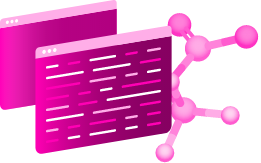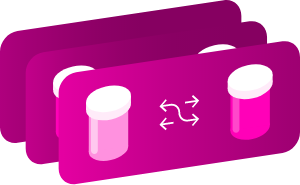Identification
- Summary
-
Ansuvimabis a fully human monoclonal IgG1 antibody directed against the GP1,2 surface protein of Zaire ebolavirus that is an effective treatment for Ebola virus disease.
- Brand Names
-
Ebanga
- Generic Name
- Ansuvimab
- DrugBank Accession Number
- DB16385
- Background
-
Infection with pathogenic filoviruses, such asZaire ebolavirus(Ebola virus, EBOV), can cause severe hemorrhagic fever in humans, resulting in frequent outbreaks with case fatality rates as high as 90%.1,2Virtually all steps of the EBOV lifecycle have been targeted for therapeutic development. However, to date, the most successful method appears to be the development of monoclonal antibodies (mAbs) against the GP1,2surface glycoprotein, as evidenced by the previously approved INMAZEB™ (REGN-EB3, a cocktail ofatoltivimab,odesivimab, andmaftivimab), the now approved ansuvimab, and ZMapp, which remains in clinical trials.1Ansuvimab, formerly mAb114, is a fully human IgG1 mAb derived from a survivor of the 1995 Kikwit EBOV outbreak 11 years after infection, which displays strong glycan-independent binding to a conserved region of the GP1,2protein that is responsible for interacting with the host NPC1 protein to mediate EBOV endolysosomal escape, a key step in the EBOV lifecycle.3,4,5A randomized, controlled trial of four investigational therapies for Ebola virus disease (EVD) in the Democratic Republic of Congo during a previous outbreak that began in 2018 compared ansuvimab, REGN-EB3, ZMapp, andremdesivir, a nucleoside analogue designed to inhibit viral replication, showed ansuvimab and REGN-EB3 to be superior, with improved patient survival and faster viral clearance rates.6
Ansuvimab received FDA approval on December 21, 2020, and is currently marketed as Ebanga by Ridgeback Biotherapeutics, LP. Ansuvimab is just the second FDA-approved treatment for EVD.7
- Type
- Biotech
- Groups
- Approved, Investigational
- Synonyms
-
- Ansuvimab
- ansuvimab-zykl
- External IDs
-
- Anti-ebola monoclonal antibody mAb114
- EboV mAb114
- EVB-114
- EVB114
- MAB-114
- MAb114
- VRC-EBOMAB092-00-AB
- WHO 11568
Pharmacology
- Indication
-
Ansuvimab is indicated for the treatment ofZaire ebolavirusinfection in adult and pediatric patients, including neonates born to a mother who tests positive forZaire ebolavirusby RT-PCR.7
Ansuvimab has not been shown to be effective against other species within theEbolavirusandMarburgvirusgenera; factors such as the possible emergence of resistant strains suggest local information on circulatingZaire ebolavirusstrains should be consulted before initiating treatment.7
 Reduce drug development failure ratesBuild, train, & validate machine-learning models
Reduce drug development failure ratesBuild, train, & validate machine-learning models
with evidence-based and structured datasets.Build, train, & validate predictive machine-learning models with structured datasets. - Associated Conditions
- Contraindications & Blackbox Warnings
-
 Avoid life-threatening adverse drug eventsImprove clinical decision support with information oncontraindications & blackbox warnings, population restrictions, harmful risks, & more.Avoid life-threatening adverse drug events & improve clinical decision support.
Avoid life-threatening adverse drug eventsImprove clinical decision support with information oncontraindications & blackbox warnings, population restrictions, harmful risks, & more.Avoid life-threatening adverse drug events & improve clinical decision support. - Pharmacodynamics
-
Ansuvimab is a human IgG1 monoclonal antibody directed against theZaire ebolavirusGP1,2surface glycoprotein that is produced by recombinant DNA technology in Chinese Hamster Ovary (CHO) cells. The exposure-response relationship of ansuvimab is not currently understood, although the recommended treatment comprises only a single dose. Despite a good overall safety profile, ansuvimab treatment carries a risk of potentially life-threatening hypersensitivity reactions, including infusion-related reactions; in the case of hypersensitivity reactions, ansuvimab should be discontinued, and supportive care initiated immediately.7
- Mechanism of action
-
Zaire ebolavirus(EBOV埃博拉病毒)e of six species within theEbolavirusgenus, which itself is one of six genera within theFiloviridaefamily.1Infection with pathogenic filoviruses such as EBOV in humans can result in hemorrhagic fever with very high fatality rates (25-90%).1,2Following infection, a variable latency period of ~2-21 days occurs before the onset of symptoms, which are vague at first, including fatigue, fever, aches, myalgia, and gastrointestinal complaints, but that progress in severe disease to both internal and external bleeding, multiorgan failure, secondary infections, meningoencephalitis, hypotension, and shock.1,2The pathogenesis of EBOV is poorly understood but is thought to be multifactorial: immune suppression, cytokine dysregulation, vascular dysfunction, and abnormal coagulation.1
EBOV is a non-segmented negative-sense RNA virus whose genome comprises seven genes, including the GP1,2glycoprotein involved in host cell entry and subsequent viral escape into the cytoplasm. GP1,2binds to one of several possible host receptors such as various lectins and TYRO3 receptor tyrosine kinases, β1 integrins, the asialoglycoprotein receptor, human folate receptor-α, and TIM1. Following internalization into endolysosomes by macropinocytosis, GP1,2is cleaved by host cathepsins into a fusion-competent form termed GPCL, which subsequently binds the Niemann-Pick C1 protein (NPC1) to induce fusion of the host endolysosomal and viral membranes that releases the viral nucleocapsids into the host cytoplasm.1
The EBOV GP is a class I fusion protein comprising GP1and GP2subunits, transcribed as a single gene and proteolytically processed into individual subunits linked by disulphide bonds; three subunit heterodimers subsequently associate to form the mature chalice-shaped GP1,2.1,3Ansuvimab (formerly mAb114) is a fully human IgG1 monoclonal antibody (mAb) derived from an Ebola virus disease (EVD) survivor from the 1995 Kikwit EBOV outbreak 11 years after infection that binds to GP1,2over a region encompassing both the glycan cap and GP1core, although the glycan cap is dispensable for binding.3,4,5Furthermore, structural studies reveal that ansuvimab binds to regions of the GP1core thought to be important for GPCLinteraction with NPC1 and blocks NPC1-GP interactionsin vitro.3Furtherin vitrostudies revealed that ansuvimab exhibits strong GP binding (EC50of 0.02 μg/mL), the ability to neutralize GP-expressing lentiviral particles (IC50of 0.09 μg/mL), and strong antibody-dependent cell-mediated cytotoxicity (ADCC) at concentrations of 0.03 μg/mL.4Hence, the proposed ansuvimab mechanism of action is through direct blockage of EBOV endolysosome escape and ADCC-mediated killing of EBOV-infected cells.
Target Actions Organism AEnvelope glycoprotein antagonistZaire ebolavirus (strain Mayinga-76) - Absorption
-
The absorption of ansuvimab was evaluated in 18 healthy volunteers aged 18-60 years in an open-label phase 1 study. Ansuvimab administered at 5 mg/kg produced a Cmaxof 198.45 ± 45.15 μg/mL, a Tmaxof 3.21 ± 1.56 h, and an AUC0-28dof 1480 ± 304 μg*day/mL. The corresponding values for 25 mg/kg were: Cmaxof 829.38 ± 237.40 μg/mL, Tmaxof 2.99 ± 2.16 h, and AUC0-28dof 8586 ± 900 μg*day/mL, while the corresponding values for 50 mg/kg were: Cmaxof 1961.21 ± 339.83 μg/mL, Tmaxof 2.75 ± 1.63 h, and AUC0-28dof 18588 ± 3627 μg*day/mL.5Overall, the pharmacokinetic profile of ansuvimab is consistent with other IgG1 monoclonal antibodies.7
- Volume of distribution
-
The steady-state volume of distribution in healthy volunteers administered a single dose of 5 mg/kg, 25 mg/kg, or 50 mg/kg ansuvimab was 5.08 ± 0.88, 3.93 ± 0.50, and 4.16 ± 0.74 L, respectively.5
- Protein binding
-
Not Available
- Metabolism
-
Ansuvimab is expected to be degraded by various proteolytic and catabolic processes within the body, like other monoclonal antibodies.
- Route of elimination
-
Not Available
- Half-life
-
The half-life of ansuvimab following a single administration of 5 mg/kg, 25 mg/kg, or 50 mg/kg was 20.1 ± 6.9, 26.7 ± 3.8, and 23.6 (no calculated standard deviation available) days, respectively.5
- Clearance
-
The clearance of ansuvimab following a single administration of 5 mg/kg, 25 mg/kg, or 50 mg/kg was 199 ± 45, 108 ± 21, and 115 ± 15 mL/day, respectively.5
- Adverse Effects
-
 Improve decision support & research outcomesWith structured adverse effects data, including:blackbox warnings, adverse reactions, warning & precautions, & incidence rates.Improve decision support & research outcomes with our structured adverse effects data.
Improve decision support & research outcomesWith structured adverse effects data, including:blackbox warnings, adverse reactions, warning & precautions, & incidence rates.Improve decision support & research outcomes with our structured adverse effects data. - Toxicity
-
Toxicity information regarding ansuvimab is not readily available. Patients experiencing an overdose are at an increased risk of severe adverse effects such as hypotension, tachycardia, tachypnea, pyrexia, chills, diarrhea, vomiting, and hypersensitivity reactions including infusion-related reactions. Symptomatic and supportive measures are recommended.7
- Pathways
- Not Available
- Pharmacogenomic Effects/ADRsBrowse all" title="" id="snp-actions-info" class="drug-info-popup" href="javascript:void(0);">
- Not Available
Interactions
- Drug InteractionsLearn More" title="" id="structured-interactions-info" class="drug-info-popup" href="javascript:void(0);">
-
This information should not be interpreted without the help of a healthcare provider. If you believe you are experiencing an interaction, contact a healthcare provider immediately. The absence of an interaction does not necessarily mean no interactions exist.
Drug Interaction Integrate drug-drug
interactions in your softwareAbciximab The risk or severity of adverse effects can be increased when Abciximab is combined with Ansuvimab. Adalimumab The risk or severity of adverse effects can be increased when Adalimumab is combined with Ansuvimab. Adenovirus type 7 vaccine live The therapeutic efficacy of Adenovirus type 7 vaccine live can be decreased when used in combination with Ansuvimab. Aducanumab The risk or severity of adverse effects can be increased when Aducanumab is combined with Ansuvimab. Alemtuzumab The risk or severity of adverse effects can be increased when Alemtuzumab is combined with Ansuvimab. Alirocumab The risk or severity of adverse effects can be increased when Alirocumab is combined with Ansuvimab. Amivantamab The risk or severity of adverse effects can be increased when Ansuvimab is combined with Amivantamab. Anifrolumab The risk or severity of adverse effects can be increased when Anifrolumab is combined with Ansuvimab. Anthrax immune globulin human The risk or severity of adverse effects can be increased when Anthrax immune globulin human is combined with Ansuvimab. Anthrax vaccine The therapeutic efficacy of Anthrax vaccine can be decreased when used in combination with Ansuvimab.  Identify potential medication risksEasily compare up to 40 drugs with our drug interaction checker.Get severity rating, description, and management advice.Learn more
Identify potential medication risksEasily compare up to 40 drugs with our drug interaction checker.Get severity rating, description, and management advice.Learn more - Food Interactions
- No interactions found.
Products
-
 Drug product information from 10+ global regionsOur datasets provide approved product information including:
Drug product information from 10+ global regionsOur datasets provide approved product information including:
dosage, form, labeller, route of administration, and marketing period.从超过世界人口访问药物产品信息l regions. - International/Other Brands
- Ebanga
- Brand Name Prescription Products
-
Name Dosage Strength Route Labeller 市场开始 Marketing End Region Image Ebanga Injection, powder, lyophilized, for solution; Kit 400 mg/8mL Intravenous Ridgeback Biotherapeutics, Lp 2020-12-21 Not applicable US
Categories
- ATC Codes
- J06BD04 — Ansuvimab
- Drug Categories
-
- Amino Acids, Peptides, and Proteins
- Anti-Infective Agents
- Antibodies
- Antibodies, Monoclonal
- Antiinfectives for Systemic Use
- Antiviral Agents
- Antiviral monoclonal antibodies
- Blood Proteins
- Globulins
- Immune Sera and Immunoglobulins
- Immunoglobulins
- Immunoproteins
- Proteins
- Serum Globulins
- Treatments for Ebola Virus Disease
- Classification
- Not classified
- Affected organisms
-
- Zaire ebolavirus (strain Mayinga-76)
Chemical Identifiers
- UNII
- TG8IQ19NG2
- CAS number
- 2375952-29-5
References
- Synthesis Reference
-
Corti D, Misasi J, Mulangu S, Stanley DA, Kanekiyo M, Wollen S, Ploquin A, Doria-Rose NA, Staupe RP, Bailey M, Shi W, Choe M, Marcus H, Thompson EA, Cagigi A, Silacci C, Fernandez-Rodriguez B, Perez L, Sallusto F, Vanzetta F, Agatic G, Cameroni E, Kisalu N, Gordon I, Ledgerwood JE, Mascola JR, Graham BS, Muyembe-Tamfun JJ, Trefry JC, Lanzavecchia A, Sullivan NJ: Protective monotherapy against lethal Ebola virus infection by a potently neutralizing antibody. Science. 2016 Mar 18;351(6279):1339-42. doi: 10.1126/science.aad5224.
- General References
-
- Hoenen T, Groseth A, Feldmann H: Therapeutic strategies to target the Ebola virus life cycle. Nat Rev Microbiol. 2019 Oct;17(10):593-606. doi: 10.1038/s41579-019-0233-2. Epub 2019 Jul 24. [Article]
- Inungu J, K Iheduru-Anderson,苹果橙汁:复发性Ebolavirus disease in the Democratic Republic of Congo: update and challenges. AIMS Public Health. 2019 Nov 20;6(4):502-513. doi: 10.3934/publichealth.2019.4.502. eCollection 2019. [Article]
- Misasi J, Gilman MS, Kanekiyo M, Gui M, Cagigi A, Mulangu S, Corti D, Ledgerwood JE, Lanzavecchia A, Cunningham J, Muyembe-Tamfun JJ, Baxa U, Graham BS, Xiang Y, Sullivan NJ, McLellan JS: Structural and molecular basis for Ebola virus neutralization by protective human antibodies. Science. 2016 Mar 18;351(6279):1343-6. doi: 10.1126/science.aad6117. Epub 2016 Feb 25. [Article]
- Corti D, Misasi J, Mulangu S, Stanley DA, Kanekiyo M, Wollen S, Ploquin A, Doria-Rose NA, Staupe RP, Bailey M, Shi W, Choe M, Marcus H, Thompson EA, Cagigi A, Silacci C, Fernandez-Rodriguez B, Perez L, Sallusto F, Vanzetta F, Agatic G, Cameroni E, Kisalu N, Gordon I, Ledgerwood JE, Mascola JR, Graham BS, Muyembe-Tamfun JJ, Trefry JC, Lanzavecchia A, Sullivan NJ: Protective monotherapy against lethal Ebola virus infection by a potently neutralizing antibody. Science. 2016 Mar 18;351(6279):1339-42. doi: 10.1126/science.aad5224. Epub 2016 Feb 25. [Article]
- Gaudinski MR, Coates EE, Novik L, Widge A, Houser KV, Burch E, Holman LA, Gordon IJ, Chen GL, Carter C, Nason M, Sitar S, Yamshchikov G, Berkowitz N, Andrews C, Vazquez S, Laurencot C, Misasi J, Arnold F, Carlton K, Lawlor H, Gall J, Bailer RT, McDermott A, Capparelli E, Koup RA, Mascola JR, Graham BS, Sullivan NJ, Ledgerwood JE: Safety, tolerability, pharmacokinetics, and immunogenicity of the therapeutic monoclonal antibody mAb114 targeting Ebola virus glycoprotein (VRC 608): an open-label phase 1 study. Lancet. 2019 Mar 2;393(10174):889-898. doi: 10.1016/S0140-6736(19)30036-4. Epub 2019 Jan 24. [Article]
- Mulangu S, Dodd LE, Davey RT Jr, Tshiani Mbaya O, Proschan M, Mukadi D, Lusakibanza Manzo M, Nzolo D, Tshomba Oloma A, Ibanda A, Ali R, Coulibaly S, Levine AC, Grais R, Diaz J, Lane HC, Muyembe-Tamfum JJ, Sivahera B, Camara M, Kojan R, Walker R, Dighero-Kemp B, Cao H, Mukumbayi P, Mbala-Kingebeni P, Ahuka S, Albert S, Bonnett T, Crozier I, Duvenhage M, Proffitt C, Teitelbaum M, Moench T, Aboulhab J, Barrett K, Cahill K, Cone K, Eckes R, Hensley L, Herpin B, Higgs E, Ledgerwood J, Pierson J, Smolskis M, Sow Y, Tierney J, Sivapalasingam S, Holman W, Gettinger N, Vallee D, Nordwall J: A Randomized, Controlled Trial of Ebola Virus Disease Therapeutics. N Engl J Med. 2019 Dec 12;381(24):2293-2303. doi: 10.1056/NEJMoa1910993. Epub 2019 Nov 27. [Article]
- DailyMed: EBANGA (ansuvimab) injection [Link]
- External Links
Clinical Trials
- Clinical TrialsLearn More" title="" id="clinical-trials-info" class="drug-info-popup" href="javascript:void(0);">
-
Phase Status Purpose Conditions Count 2 Not Yet Recruiting Prevention Ebolavirus Disease 1 2, 3 Completed Treatment Ebola Viruses 1 1 Completed Treatment Healthy Adult Immune Responses to Vaccine 1 Not Available Available Not Available Hemorrhagic Fever, Ebola 1
Pharmacoeconomics
- Manufacturers
-
Not Available
- Packagers
-
Not Available
- Dosage Forms
-
Form Route Strength Injection, powder, lyophilized, for solution; kit Intravenous 400 mg/8mL - Prices
- Not Available
- Patents
- Not Available
Properties
- State
- Liquid
- Experimental Properties
- Not Available
Targets

insights and accelerate drug research.
- Kind
- Protein
- Organism
- Zaire ebolavirus (strain Mayinga-76)
- Pharmacological action
-
Yes
- Actions
-
Antagonist
- General Function
- Envelope glycoprotein Trimeric GP1,2 complexes form the virion surface spikes and mediate the viral entry processes, with GP1 acting as the receptor-binding subunit and GP2 as the membrane fusion subunit. At later times of infection, downregulates the expression of various host cell surface molecules that are essential for immune surveillance and cell adhesion. Down-modulates several integrins including ITGA1, ITGA2, ITGA3, ITGA4, ITGA5, ITGA6, ITGAV and ITGB1. This decrease in cell adhesion molecules may lead to cell detachment, contributing to the disruption of blood vessel integrity and hemorrhages developed during infection (cytotoxicity). Interacts with host TLR4 and thereby stimulates the differentiation and activation of monocytes leading to bystander death of T-lymphocytes (PubMed:28542576). Downregulates as well the function of host natural killer cells (PubMed:30013549). Counteracts the antiviral effect of host BST2/tetherin that restricts release of progeny virions from infected cells. However, cooperates with VP40 and host BST2 to activate canonical NF-kappa-B pathway in a manner dependent on neddylation.
- Specific Function
- Identical protein binding
- Gene Name
- GP
- Uniprot ID
- Q05320
- Uniprot Name
- Envelope glycoprotein
- 分子量
- 74463.855 Da
References
- Misasi J, Gilman MS, Kanekiyo M, Gui M, Cagigi A, Mulangu S, Corti D, Ledgerwood JE, Lanzavecchia A, Cunningham J, Muyembe-Tamfun JJ, Baxa U, Graham BS, Xiang Y, Sullivan NJ, McLellan JS: Structural and molecular basis for Ebola virus neutralization by protective human antibodies. Science. 2016 Mar 18;351(6279):1343-6. doi: 10.1126/science.aad6117. Epub 2016 Feb 25. [Article]
- Corti D, Misasi J, Mulangu S, Stanley DA, Kanekiyo M, Wollen S, Ploquin A, Doria-Rose NA, Staupe RP, Bailey M, Shi W, Choe M, Marcus H, Thompson EA, Cagigi A, Silacci C, Fernandez-Rodriguez B, Perez L, Sallusto F, Vanzetta F, Agatic G, Cameroni E, Kisalu N, Gordon I, Ledgerwood JE, Mascola JR, Graham BS, Muyembe-Tamfun JJ, Trefry JC, Lanzavecchia A, Sullivan NJ: Protective monotherapy against lethal Ebola virus infection by a potently neutralizing antibody. Science. 2016 Mar 18;351(6279):1339-42. doi: 10.1126/science.aad5224. Epub 2016 Feb 25. [Article]
- DailyMed: EBANGA (ansuvimab) injection [Link]
Drug created at December 22, 2020 16:06 / Updated at August 06, 2021 21:26




